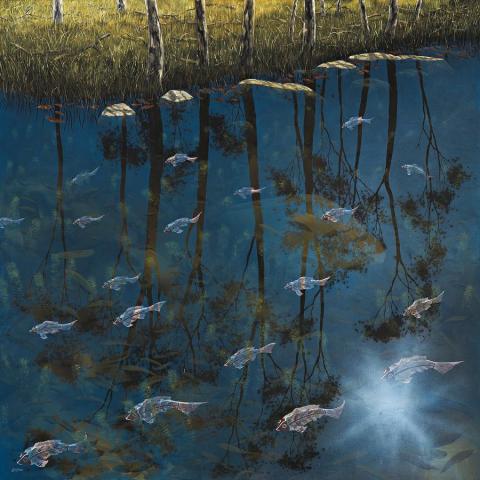FISH, BARMAH FOREST, c.1994
LIN ONUS
synthetic polymer paint on canvas
183.0 x 183.0 cm
signed lower left: Lin Onus
Company collection, Melbourne
The Barmah Forest on the Victorian banks of the Murray River is Lin Onus's ancestral country and spiritual home. Born the son of a Scottish mother and a Yorta Yorta man from the Aboriginal mission of Cummerangunja near Echuca, Onus would regularly return to his father's county where he would sit along the banks of the Murray River looking out over the Barmah Forest and its great trees reflected in the mirrored waters. There his uncle Aaron Briggs, also known as 'the old man of the forest', would tell Onus about his Koori heritage and the stories of the river.1 It is this spiritual narrative that ebbs and flows through this important body of works, which culminated in the critical example, Barmah Forest of 1994 now in the collection of the Australian Heritage Commission, Canberra. Our painting, Fish, Barmah Forest, highlights the reed beds along the river which provide a protective habitat for numerous threatened plant and animal species, including fish, birds and reptiles. Onus captures this sanctuary-like quality of the Barmah Forest wetlands in his depiction of the teeming aquatic life under the reflective surface of the waters. It is an environment of great abundance where all life seems to exist in balance with a natural order. A sense of the eternal quality imbued in this ancient landscape became a hallmark of Onus's Barmah works.
Although Lin Onus disagreed with the nomenclature, he is often regarded as an 'urban aboriginal artist' and undoubtedly many of his works have a solid political message about appropriation, land rights, human rights and marginalisation. He grew up in Deepdene, Melbourne and suffered the torments of school bullying and the fear and loathing inherent in1950s and '60s suburban racism. Yet his activism found its greatest voice through his prodigious talent for painting and his ability to stop people in their tracks with his powerful image making. He took to his subject with a velvet hammer and used his own brand of humour to lure the audience to engage with his message. Works such as Dingoes of 1989 in the National Gallery of Australia, Canberra powerfully exploits this quality in its use of painted dingo pups, rabbit traps and cyclone fences. As such, Onus's images are often loaded with cultural history and metaphor. In Fish, Barmah Forest, this undercurrent is sensed in the rarrk painting on the swimming fish, one of his most popular motifs. However, these Murray River paintings speak further of an everlasting landscape, its enduring beauty characteristically reflected in the mirrored surface of the waterways Onus loved to paint.
1. Neale, M., Urban Dingo - the Art and Life of Lin Onus 1948-1996, Queensland Art Gallery, Brisbane, 2000, pp. 13-14
LARA NICHOLLS
